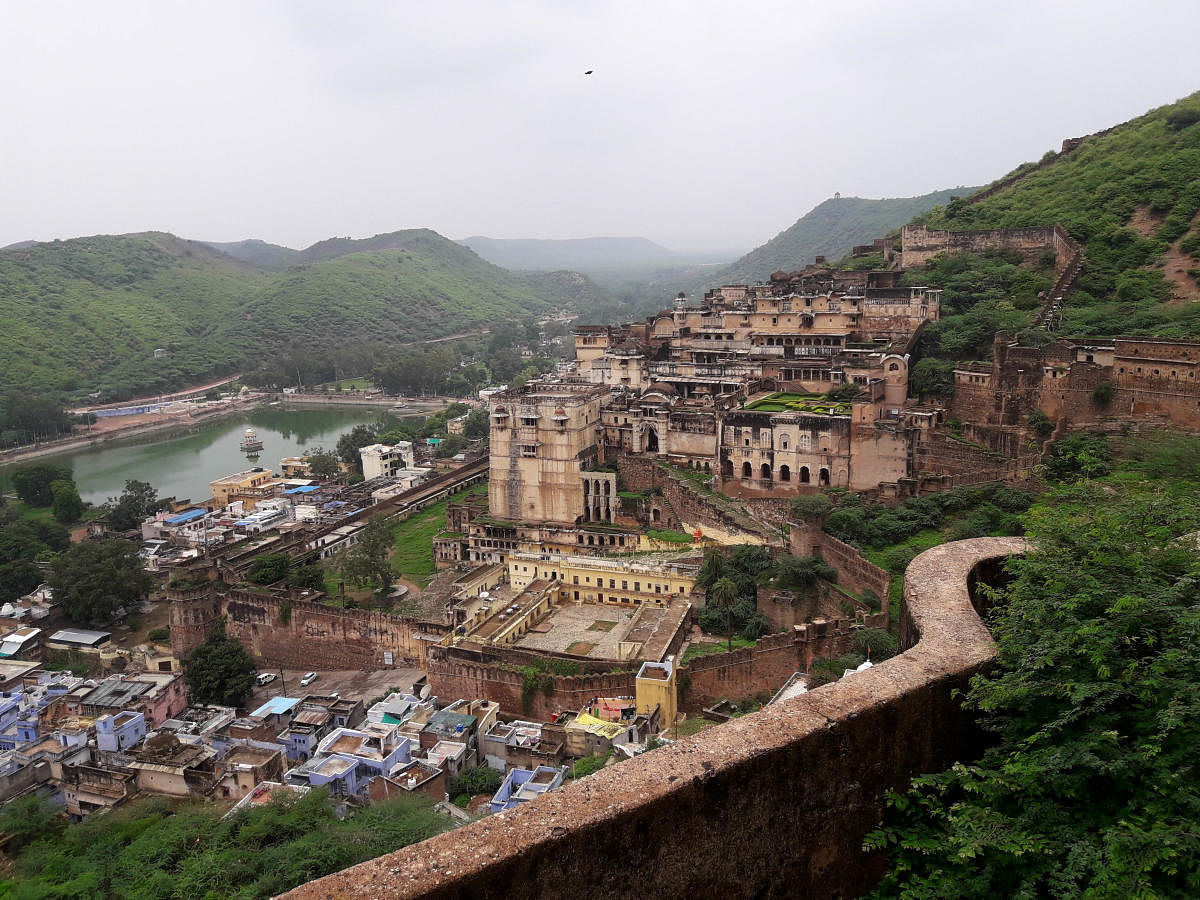
The moment we landed in Bundi, we fell in love with it. It had rained just before we landed and the aroma of the wet soil was rising in the air. Somewhere, we could hear the call of a peacock. An autorickshaw from the bus stand to the guest house took us through many narrow lanes that suddenly rose and dipped. Montu and Tampi welcomed us with a pleasant smile into their Shivam Guest House. Dev served hot steaming white rice, chapatis, lip-smacking dal and potato curry. After this tasty meal, we retired for the night.
Glorious past
The chirping of birds announced the arrival of dawn, and we took a stroll near Nawal Sagar Lake. The fort’s reflection in the lake was disturbed by a kingfisher which occasionally dived into the waters in search of fish. Hordes of pigeons hovered all around us as locals fed them with grains.
Earlier, this region was home to some ancient local tribes, which was then captured by the Hada Rajput king Rao Deva Hada. He established control over the city of Bundi in 1241 AD. The name ‘Bundi’ is derived from the tribe’s chieftain’s name, Bunda Meena. The successive Hada kings beautified the city with palaces, hunting lodges and a glittering series of stepwells.
We engaged an autorickshaw for sightseeing. The first place on our itinerary was Chaurasi Khambon ki Chhatri, an 84-pillared cenotaph built by Rao Anirudh Singh in 1683 AD in the memory of his foster brother Deva. According to historians, the number 84 refers to the 84 erotic postures described in Kamasutra or the 84 cycles of rebirths which one has to pass through for attaining salvation.
Bundi abounds in stepwells and is often called as the ‘city of stepwells’. Lying unused since the colonial period, most of them have fallen into a total state of disrepair, and now only a handful of them remain. My personal choice was Raniji ki Baori, a 300-year-old and 46-metre-deep stepwell built in 1699 AD by Rani Nathavatji, the queen of Rao Anirudh Singh. It has impressive carvings on the pillars and intricate murals on its toranas and gates.
We reserved the full afternoon for the massive Taragarh Palace Fortress, the star attraction of Bundi, constructed by Hada kings. Rao Deva commissioned the fort in 1298 AD and Rao Raja Bar Singh built it in 1354 AD. It stands tall at a height of 1,426 feet.
A steep stone ramp took us to Hathi Pol (Elephant Gate), the main entrance to the palace complex. It is adorned with intricately carved pillars, panels, impressively projecting balconies, latticed windows, elegant doors and marvellous arches, and ranks amongst the finest architectural compositions of the medieval period. Rao Balwant Singh had started the construction of this palace complex, but different rulers are said to have added to it over a period of time.
The smell of bat-droppings was too intense to ignore as we set out to explore Ratan Daulat or Diwan-e-Aam (hall of public audience). It consists of an impressive wide hall and has fine arrangements for keeping torches in its walls. There is also a marble throne of the Hada kings.
A small door from Ratan Daulat admitted us into Chattar Mahal, built by Rao Chhatrasal Singh (1631-1658). Hathiya Sal Palace has elephant-capitalised columns and above it is Zenana Mahal, decorated with paintings showing a variety of things: Krishna’s birth, a king sitting on his simhasana, and a princess being bedecked. A narrow staircase took us to Badal Mahal, right above Zenana Mahal. It has lavishly drawn frescoes and murals depicting Krishna’s legends, court scenes, procession scenes and hunting episodes.
A distinct school of painting originated in Bundi. Since this princely state was in contact with Mughal, Mewar and Deccan states, it borrowed art elements from all three of them. Bundi paintings are characterised by some distinct features like fancy flowering trees resembling star-like blooms in rich colours like orange and green, dense forests, lush vegetations, dramatic night skies, flowing rivers. You can also notice a distinct way of depicting water by light swirls against a dark background in Bundi paintings.
Strokes of life
The most lavish display of Bundi murals is in Chitrashala (in Ummed Mahal), the UNESCO World Heritage part of the palace complex, and here we were simply lost in the world of pictures all around us. The murals depict a variety of themes such as ragamala paintings, love stories and court processions; and they are influenced by Mughal and Mewar styles.
Here, the colour scheme consists of a green background, white for human bodies, and red, blue, black and yellow for traditional dresses. We spent hours observing the minute details of many paintings — a dazzling damsel attired in a Mughal dress, a princess on the horseback being attended by many women, a dhola waiting for his spouse under the shade of a tree, rasamandala (the great cosmic dance) being enacted on the banks of Yamuna, and more.
A steep ramp showed us the way to Taragarh Fort atop the hill. The climb was too deserted, overgrown with weeds and vegetation. Since it was too dark to visit the place, we bade goodbye to the palace fortress. We tasted tea at Dau Dayal Restaurant in Tilak Chowk, spent some time with our hosts, and left after relishing a yummy dinner, with a promise to return to Bundi soon.